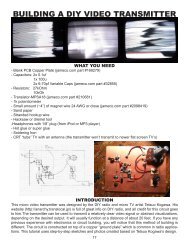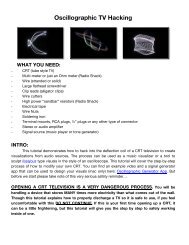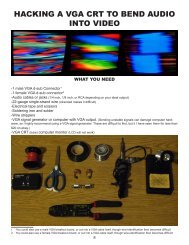CRACKING RAY TUBES - Cracked Ray Tube
CRACKING RAY TUBES - Cracked Ray Tube
CRACKING RAY TUBES - Cracked Ray Tube
You also want an ePaper? Increase the reach of your titles
YUMPU automatically turns print PDFs into web optimized ePapers that Google loves.
8. Repeat this process a few more times. The more wire you wind will result in a more powerful magnet<br />
but greater overall resistance. I usually wind my mine until I reach 5 Ohms of resistance. A good<br />
rule of thumb is that each up and down wind = 1 Ohm. So going up and down about 5 times is usually<br />
sufficient. But anything around 4 – 8 Ohms is good. If none of this makes sense, don’t worry and just<br />
experiment.<br />
To test the resistance of your magnet so far, find a stopping point at one of the ends and tape down the<br />
wire. Take your sand paper and rub off the insulation on both ends of the wound wire. This removes the<br />
colored insulation and exposes the bare wire. Take your multi-meter and test the resistance between<br />
the two points. If it is sufficient then snip off your wire, but if it’s not, keep on winding.<br />
9. When your finished winding, tape up length of the rod one last time and snip off the remaining wire<br />
leaving a few inches for a tail. Remove the magnet from the drill chuck and turn it over. You may notice<br />
that the bottom side closest to the chuck is not very well secured. Place some tape around the bottom<br />
covering the exposure to secure it.<br />
37






